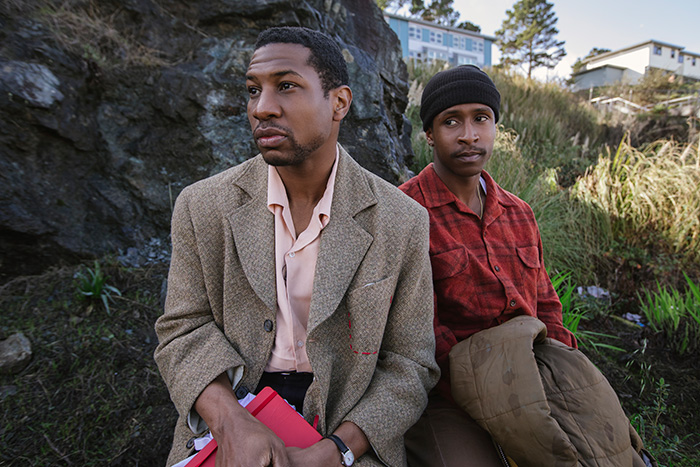You don’t get to hate it unless you love it.
One of the casualties of gentrification in San Francisco over the past half century was the Victorian home that Jimmie Fails’ (Jimmie Fails) grandfather built in the Fillmore District circa 1946. He feels its effect every single day too—enough that he and best friend Montgomery Allen (Jonathan Majors) take the bus to visit it when they know the new owners will be out. While Mont sits across the street to sketch its exterior, Jimmie walks through the gate to touch-up the paint and take care of the garden. He refuses to let his grandfather’s work get destroyed by misuse even if the woman who catches him fixing her house threatens to call the police. This structure is in his bones. It’s a metaphorical symbol for his soul.
So Jimmie hatches a plan upon seeing the property empty after an estate dispute. He and Mont go in, fix it up, and work towards claiming squatters’ rights much like how his con artist of a father (Rob Morgan) would in the past. He changes the locks, brings over all his grandfather’s old furniture from storage at his Auntie’s (Tichina Arnold), and attempts to get utility bills transferred over to his name. The house is his last connection to a city that has forgotten not only him, but also Black Americans in general. It proves their worth amongst the white people moving in with complaints that they’re living in “former crack dens.” It shows what Black men and women did to help establish San Francisco’s beauty.

Director Joe Talbot (who co-wrote with Rob Richert after fleshing the story out with long-time friend and partial inspiration Fails) lends a fantastical lens to the experience as optimism and hope shine above the absurdity of a young Black man moving into a home without legal connection—just nostalgia. His stylistic flourishes flirt with becoming over-the-top distractions since the whole remains firmly entrenched in reality despite these many surrealistic activities unfolding on the periphery. We laugh when a man ascends a literal soapbox to rail against the white scientists in HAZMAT suits cleaning up the water where they live even if he has a point. We laugh at a group of shit-talking gangsters mocking Jimmie and Mont even as they poignantly speak to toxic masculine identity.
The Last Black Man in San Francisco can be disorienting as a result since we’re constantly flipping from comedic undertones to the drama of heavy psychological turmoil. One minute we’re laughing as Nitty (Antoine Redus) confronts Kofi (Jamal Trulove) at the behest of their fellow “gangsters” about being soft and the next we’re saddened by the latter’s inability to embrace who he wants to be before watching him sacrifice a real human connection for street credibility. We move from the weirdness that is Mont acting as though life occurs around him solely to inspire his plays (he even gives “direction” to real people living their lives) to him being forced to engage with the world on a personal level no matter the pain it will bring.
This strange duality exists throughout the film—sometimes to its detriment. Give Talbot and company credit, though, since it also helps punctuate its successes more. After every head-scratching choice arrives two emotionally wrought decisions that hit hard. After every odd interaction come two brilliant ones so complementarily earnest that we must question whether those “missteps” were necessary to achieve the level of profundity that follows. It doesn’t hurt that the production design is exquisitely captured by gorgeous cinematography or that its score and heartfelt needle-drops prove so powerful. Add Majors’ stunningly restrained performance and Fails’ charismatically empathetic screen debut and it’s impossible not to get swept up by the film’s artistic potency. What I felt were off-putting idiosyncrasies at the start inevitably become charming quirks to remember fondly.

It’s not surprising that Talbot and Fails’ work has received a somewhat divisive response after bowing at Sundance—beyond the reductive backlash of being a Black story told by a white director. You either go with the flow or find yourself swimming against the current. The first hour had me leaning towards the latter before a couple details during the second hour exposed what existed beneath the tonal artifice in order for everything to click into place. Once it did I really saw the sorrow in Jimmie and Mont’s eyes as more than a superficially downtrodden quirkiness. The fantasy became less about what Talbot is bringing to the table visually and more about how these two characters are deluding themselves into thinking their dreams are guaranteed.
Dreams never are. Perseverance isn’t enough to reach the apex of your personal Sisyphean hilltop. Having a cheerleader in your corner isn’t enough for universal acclaim. You may have the biggest heart of anyone and yet you could still fall victim to a bullet because of one mistake. Is the risk worth it? Maybe an ordinary life dictated by forces well beyond your control is all you’re destined to have. The question is therefore whether that can be enough. You don’t have to give up on your dreams. You merely have to temper them a bit and rediscover what it is about them that you crave. Does Jimmie need this house (also San Francisco) because it’s his? Or is it simply easier to reclaim something ready-made than create your own?
photography:
[1] Jonathan Majors, Jimmie Fails. Photo by Peter Prato, Courtesy of A24
[2] Rob Morgan, Jimmie Fails. Courtesy of A24
[3] Danny Glover, Jonathan Majors. Courtesy of A24

